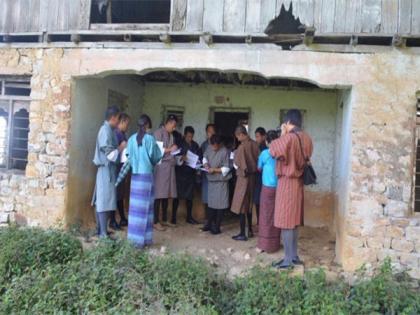Earthquake of magnitude 3.5 strikes Bhutan
By ANI | Updated: June 14, 2025 00:53 IST2025-06-14T00:46:49+5:302025-06-14T00:53:26+5:30
Thimphu [Bhutan], June 14 : An earthquake of magnitude 3.5 has struck Bhutan, a statement by the National Center ...

Earthquake of magnitude 3.5 strikes Bhutan
Thimphu [Bhutan], June 14 : An earthquake of magnitude 3.5 has struck Bhutan, a statement by the National Center for Seismology (NCS) said.
As per the NCS, the earthquake occurred at a shallow depth of 10km on late Friday, making it susceptible to aftershocks.
In a post on X, the NCS said, "EQ of M: 3.5, On: 13/06/2025 20:42:36 IST, Lat: 27.14 N, Long: 89.11 E, Depth: 10 Km, Location: Bhutan."
EQ of M: 3.5, On: 13/06/2025 20:42:36 IST, Lat: 27.14 N, Long: 89.11 E, Depth: 10 Km, Location: Bhutan.
For more information Download the BhooKamp App https://t.co/5gCOtjcVGs @DrJitendraSingh @OfficeOfDrJS @Ravi_MoES @Dr_Mishra1966 @ndmaindia pic.twitter.com/yIQqQK8UKa
— National Center for Seismology (@NCS_Earthquake) June 13, 2025
Shallow earthquakes are generally more dangerous than deep earthquakes. This is because the seismic waves from shallow earthquakes have a shorter distance to travel to the surface, resulting in stronger ground shaking and potentially more damage to structures and greater casualties.
Bhutan is prone to earthquakes due to its location in the Himalayan Mountains, an area known for seismic activity. The country is situated along the boundary between the Indian and Eurasian tectonic plates, which collide and cause the Himalayas to rise, leading to frequent and strong earthquakes. Bhutan also experiences other natural hazards like landslides, flash floods, and Glacial Lake Outburst Floods (GLOFs).
Bhutan is located in a seismically active region, considered one of the most active in the world. It lies within seismic zones IV and V, as per the Indian Seismic Code, which are the most active zones.
The collision of the Indian and the Eurasian plates is the primary reason for Bhutan's earthquake risk. The Indian plate is moving northward, pushing the Himalayas upward, and causing stress that eventually releases as earthquakes.
Bhutan has experienced numerous earthquakes in the past, including a 2009 earthquake in Mongar with a magnitude of 6.1.
While Bhutan acknowledges the high earthquake risk, there is a lack of a comprehensive and official disaster management system in place. The government is promoting confined masonry construction to improve seismic performance in rural areas, and urban buildings undergo strict structural safety inspections.
Disclaimer: This post has been auto-published from an agency feed without any modifications to the text and has not been reviewed by an editor
Open in app